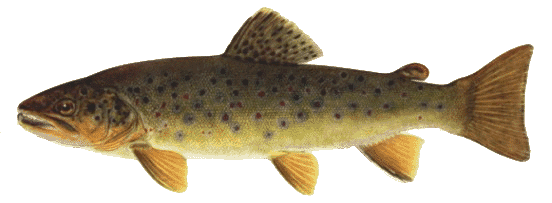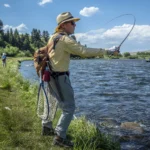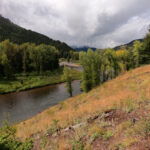 The Conejos River is dewatered for 4.5 miles below Platoro Reservoir during most of the winter — a situation that is totally unnecessary, even in low snowpack years. The typical flow during the winter is 7 cfs, but every spring they have to open the gates to deal with excess snowmelt. A little sensible forecasting could allow for a minimum bypass flow of 23 cfs, which is the minimum needed to support a year-round trout population in the stretch below Platoro Reservoir. As it is now, this stretch is stocked with hatchery fish after the reservoir flows settle down in late spring, and managed as a put-and-take fishery (8 fish daily and possession limit). It could support a wild population as does much of the Conejos, and its economic value could rise considerably, not to mention its aesthetic and biological value.
The Conejos River is dewatered for 4.5 miles below Platoro Reservoir during most of the winter — a situation that is totally unnecessary, even in low snowpack years. The typical flow during the winter is 7 cfs, but every spring they have to open the gates to deal with excess snowmelt. A little sensible forecasting could allow for a minimum bypass flow of 23 cfs, which is the minimum needed to support a year-round trout population in the stretch below Platoro Reservoir. As it is now, this stretch is stocked with hatchery fish after the reservoir flows settle down in late spring, and managed as a put-and-take fishery (8 fish daily and possession limit). It could support a wild population as does much of the Conejos, and its economic value could rise considerably, not to mention its aesthetic and biological value.
 There have been four subspecies of cutthroat trout in Colorado: Onchorhynchus clarki stomias, the Greenback Cutthroat; Onchorhynchus clarki pleuriticus, the Colorado River Cutthroat; Onchorhynchus clarki virginalis, the Rio Grande Cutthroat; and Onchorhynchus clarki mcdonaldi, the Yellowfin Cutthroat. The Yellowfin is apparently now extinct. The Greenback is listed as a “Threatened” species, and the others are limited to small portions of their original ranges. Exotic cutthroats have been stocked in some watersheds, and active projects toward native restoration are going on in several locations.
There have been four subspecies of cutthroat trout in Colorado: Onchorhynchus clarki stomias, the Greenback Cutthroat; Onchorhynchus clarki pleuriticus, the Colorado River Cutthroat; Onchorhynchus clarki virginalis, the Rio Grande Cutthroat; and Onchorhynchus clarki mcdonaldi, the Yellowfin Cutthroat. The Yellowfin is apparently now extinct. The Greenback is listed as a “Threatened” species, and the others are limited to small portions of their original ranges. Exotic cutthroats have been stocked in some watersheds, and active projects toward native restoration are going on in several locations.
 In all honesty, though, I have to acknowlege that where there are wild populations of Browns, Brookies, and Rainbows in Colorado, that their wildness requires a certain amount of respect. What can we do? At the very least, let’s not lose any more native trout, and let’s try to restore them as much as possible. I think this can be done without laying waste to existing populations of exotics, although where cutthroat are being restored, any brook trout will have to be removed, since they tend to displace the native trout. Let’s keep in mind that all trout are not functionally equivalent, and that all cutthroats are not the same. The genetic diversity that arose in different watersheds has been recognized in scientific nomenclature from species to subspecies. We need to recognize this in our management policies as well.
In all honesty, though, I have to acknowlege that where there are wild populations of Browns, Brookies, and Rainbows in Colorado, that their wildness requires a certain amount of respect. What can we do? At the very least, let’s not lose any more native trout, and let’s try to restore them as much as possible. I think this can be done without laying waste to existing populations of exotics, although where cutthroat are being restored, any brook trout will have to be removed, since they tend to displace the native trout. Let’s keep in mind that all trout are not functionally equivalent, and that all cutthroats are not the same. The genetic diversity that arose in different watersheds has been recognized in scientific nomenclature from species to subspecies. We need to recognize this in our management policies as well.
 I fully support native cutthroat restoration in as much of their original range as possible. In my opinion this will increase the value of the resource far more than managing for exotic trout. Cutthroat aren’t stupid fish; they just aren’t fished for enough, thus they are naive throughout much of their remaining range. Try fishing for Snake River Cutthroats near Jackson, Wyoming, though, and you will soon realize that these fish can learn. As for waters where native restoration is not feasible, and wild populations are present, leave them alone (except for necessary regulations).
I fully support native cutthroat restoration in as much of their original range as possible. In my opinion this will increase the value of the resource far more than managing for exotic trout. Cutthroat aren’t stupid fish; they just aren’t fished for enough, thus they are naive throughout much of their remaining range. Try fishing for Snake River Cutthroats near Jackson, Wyoming, though, and you will soon realize that these fish can learn. As for waters where native restoration is not feasible, and wild populations are present, leave them alone (except for necessary regulations).






